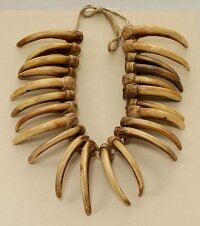|
Contact the seller in advance before paying for the order! It's All About Jewelry BeadsAt the bottom of this page, you will find links to sites about the different kinds of jewelry beads you can use. But before you scroll down, have you ever wondered about when we began to use beads, and what they were used for? History: The first things used for beading were natural materials like bone, shell, seeds, teeth, animal shields, horn, ivory, coral, Amber, Jet and wood, as these materials were fairly easy to drill holes in. As technology evolved more challenging materials came into use, like gemstones and metal. The ultimate precious natural material was pearl, because pearls were so rare. Today we produce pearls in oyster farms, but before that, they were not so easy to come by. Precious and semiprecious stones that date back to the stone ages are found in India. And metal beads were used to make jewelry throughout the world. So were materials like ceramics, pottery and glass.
Glass was used allready (and discovered by Egyptians) 5000 year ago. And the Egyptians even made faux gemstones, like Lapis Lazuli and Turquoise, from colored glass beads. In China the oldest bead findings are from 16 000 BC. There are also found beads of ostrich eggshell and fossil dinosaur eggshell dating back to 12 000 BC. Thousands of years ago gemstones were shaped by rubbing stones together and then polishing them with sand. They did not have equipment to facet or shape gemstones so the cabochon was the first shape of enhanced gems. Carved jewelry beads date back to about 7 thousand years BC. Gold, Jade, bone, Turquoise and hand polished jewels were the limited production until the Egyptians discovered glass about 3500 BC. Glass then became a very important bead making material. Glass for bead making have been produced in Europe since 13th century both in Italy and Bohemia, today's Czech republic. Bohemia was rich of Quartz and potash which are used to produce glass.
What were beads used for?
Beads and beaded artefacts have been used in trade for as long back as they have existed. And although they today are seen as something romantic and beautiful, their history is not equally beautiful. In the 15. century up to the 1860 Europeans bought slaves from Africa with colorful beads made of glass. It is said that these beads, also called slave beads were produced in such huge quantities that the slave trading ships used them as ballast on their way to buy slaves. They were of decorative glass made in Europe, mainly in Venice. The most common used were Millefiori jewelry beads. An estimate of fifteen million slaves is said to have been purchased in this way. Jewels were used as currency up to the first money appeared in 600 BC. They were also worn as talismans and amulets. Bones were strung and worn to give the owner the spirit of the animal who the bone came from, or to protect them from the particular animal. Strung semi precious gems have been, and are still used for prayer, in order to keep track of the sequence and number of prayers. 
Beaded jewelry and artefacts have also been used to express power and wealth. In Egypt stunning jewelry were created for the Faraos and other royalties. Jewelry with colored glass mixed with precious gemstones and precious metal like silver and gold make us look at them with awe even today. At first beading materials were strung, but the Egyptian later evolved bead work using special techniques to thread them together into intricate and beautiful jewelry and embellishment. Today we call this techniques bead weaving and loom work. Over time bead work expanded to create things like beaded clothing, purses, shoes and decorations. You can really see the glory of bead embroidery when you look at paintings from the 16. century, where royalty wore the most gorgeous beaded costumes and head dresses, not to speak of jewelry. Also later in the Victorian and Edwardian periods in Europe beading bloomed in fashion, especially among royalty.
Today bead work are widely used throughout the world, but mostly for decorative purposes, not so much for trading and certainly not for buying slaves. Beading is blooming as never before professionally, commercially and privately. And, there are lots and lots of jewelry beads to choose among, from precious gemstones and metal to inexpensive plastic. Getting curious? Click on the links below and I will tell you all about them.
Read about the different types of Glass beads, how they are made and their history Do you have a question?Do you have a question about jewelry making? What Other Visitors Have askedClick below to see what other visitors have asked. Poured glass beads. How are they made? |
Loans for US Residents:
Choose what you need:
Read about Jewelry trends through time 
Jewelry and polymer clay tutorial heaven

Promote Your Page Too
 One of the earliest form of jewelry beads in Africa were made of ostrich eggshell. These are still made in Africa today. In China from the 4th to 1st century BC, banded gemstones, often
One of the earliest form of jewelry beads in Africa were made of ostrich eggshell. These are still made in Africa today. In China from the 4th to 1st century BC, banded gemstones, often  The industrial revolution during the
The industrial revolution during the  Also in Africa jewels and jewelry were used to distinguish leaders from the common people, and also as expressions for politics, religion and artistic attitudes. In Nigeria, former Benin, carved stones developed on the bead market in the 15. century. These beads were considered so important that if a chief visited the leader of Benin, he would have to wear his necklaces, and if he did not, he might be condemned to death.
Also in Africa jewels and jewelry were used to distinguish leaders from the common people, and also as expressions for politics, religion and artistic attitudes. In Nigeria, former Benin, carved stones developed on the bead market in the 15. century. These beads were considered so important that if a chief visited the leader of Benin, he would have to wear his necklaces, and if he did not, he might be condemned to death.

